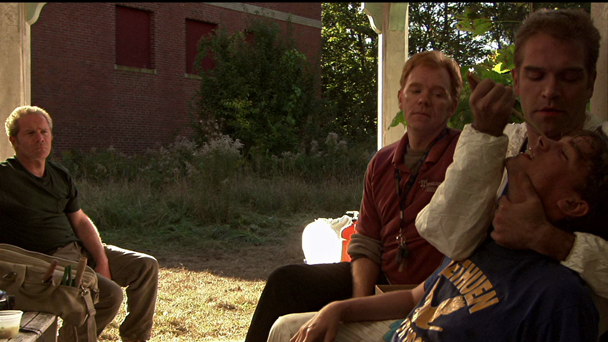Session 9
2001

Rated: R
Genre: Horror
Country: U.S.
Run-Time: 1h 37min
Director: Brad Anderson
Cast
Peter Mullan………………..Gordon Fleming
David Caruso……………….Phil
Stephen Gevedon……..Mike
Josh Lucas…………………….Hank
Brad Anderson’s 2001 asylum horror Session 9 holds the dubious distinction of being one of the most divisive films in horror history. For most moviegoers, watching Session 9 has been a “love it” or “hate it” experience. And though I understand some of the criticisms of its nay-sayers, personally, I find myself closer aligned its vocal fan-base who, for over two decades, have refused to allow Session 9 to leave the horror conversation and have subsequently succeeded in making the film a cult hit.
But before you give Session 9 a watch, I suggest that you set your expectations appropriately. The film’s lasting appeal does not come from scares, at least not in a traditional “jump-scare” sense, though many may believe it were seeing as though it is often talked up as though it were one of the scariest films ever made. If anything, Session 9′s longevity comes from its fascinating real-life asylum setting, its atmosphere, its maturity and its originality. Honestly, if you are looking for ghostly abandoned asylum frights, you might be better off watching Gonjiam: Haunted Asylum (I really enjoyed Gonjiam) or any of the other half dozen other abandoned asylum horrors with similar plots. Not that there isn’t a supernatural aspect to Session 9, its just that here it is entwined with the story’s more persistent and cerebral psychological terror.
Session 9 is about a crew of asbestos workers who have won the bid to abate the Danvers State Mental Hospital in Massachusetts. However, the bid was accepted with strings attached. Gordon (Peter Mullan), the company owner, won by placing an unrealistic one-week timeline on the project and each member of his small four-man crew will receive a $10,000 bonus only if they are successful in pulling it off.
What Gordon fails to mention is that during his initial assessment he heard a voice in the shadows calling him by name.
As writer and director, Anderson deserves a lot of credit for how much he was able to capitalize on Session 9′s location. That the Danvers State Mental Asylum is a real abandoned mental institute with a notorious history only adds to Session 9′s overall creepiness. This is, after all, the home of the pre-frontal lobotomy- that’s the one where they stick an ice pick in your eye socket to jab at your brain. Anderson finds ways to organically references as many unsettling factoids as he can about Danver’s actual history into the film’s dialogue, making the script an innovative blending of fact and fiction. And it is this hidden history that is the most interesting, self-aware aspect of Session 9. This is a film that, like the hazardous asbestos that runs through the pipes and tiles, takes advantage of terrors unseen. This environment is hostile. In fact, it is so hostile that tension is created in scenes that simply show the men doing their jobs. Those involved in the film claim that very little tampering was done to stage scenes before shooting. The graffiti, the decay, the dusty old medical equipment and even the boxes of patient records where all there before the crew started filming. And even though most of Session 9 was shot during the daytime, Mullan and Caruso were recorded on set as having unnerving encounters that are nearly as spooky as the fictional events depicted in the film.
Session 9 has been often criticized for having characters with underdeveloped character arcs, which is partly due to the abrupt brutality of its final act. But personally, I think this condemnation completely misses the subtilties of Anderson’s tightly woven script. This is a film that benefits from second viewings and reflection. While in the asylum, each member in Gordon’s crew ends up getting drawn into exploring their darkest impulses. For example, Mike (Stephen Gevedon), the law school dropout, tries to escape the reality of his failings by sneaking off and playing mysterious recordings he found of Mary, a former patient who suffers from dissociative identity disorder. The true crime mystery explored in the tapes help to connect him to a world he left behind. Phil (David Caruso) is a cynical alcoholic who keeps complicating the job by diving further into his jealousy, resentment, and paranoia. And Hank (Josh Lucas), the selfish opportunist and gambler, gives in to greed and temptation after finding a cache of valuables hidden in the walls of the basement.
And don’t get me started on Mike and Gordon. Rest assured; hubris catches up to them as well.
Session 9 also contains some truly impressive voice acting in Mary’s audio recordings. Anderson makes a bold choice, allowing us only to hear the conversations between Mary, with her many personalities, and her doctor instead of showing us the interaction through flashbacks. Instead these conversations are often heard while showing a montage the asbestos team hinting at a connection between the stories. But how strong that connection is has been the subject of considerable debate amongst fans of the film since it has been left mostly open for interpretation.
Session 9 is a fantastic example of a low-budget psychological horror. Chances are that how much you enjoy this film will depend on how well you can reconcile the simplicity of its scares with the subtle maturity of its narrative. Those who champion the movie often appreciate its ambiguities and symbolism. Many have viewed the film as a powerful exploration of toxic male behaviour. It has occasionally been labelled a modern version of The Shining. Regardless of how you might feel about it, Session 9 is not leaving the horror conversation any time soon. My own personal feelings are that any film that is this divisive is at least worth a look. That…Hank…is the safest way to uncover a buried treasure.
